Management and Operations at Toyota: A Detailed Analysis
VerifiedAdded on 2020/10/22
|22
|6107
|69
Report
AI Summary
This report provides a comprehensive analysis of Toyota's management and operational strategies. It begins with an overview of Toyota's organizational structure, comparing its centralized and decentralized approaches, and explores the roles of managers and leaders. The report delves into the application of project management techniques and situational leadership within Toyota, evaluating their strengths and weaknesses. It also examines the impact of leaders and managers on organizational success, considering both internal and external factors. The analysis covers key operational decisions, the responsibilities of leaders, and the influence of the external environment on decision-making. Finally, the report offers recommendations for future improvements in Toyota's operational efficiency, emphasizing the importance of leadership and management in achieving the company's goals.
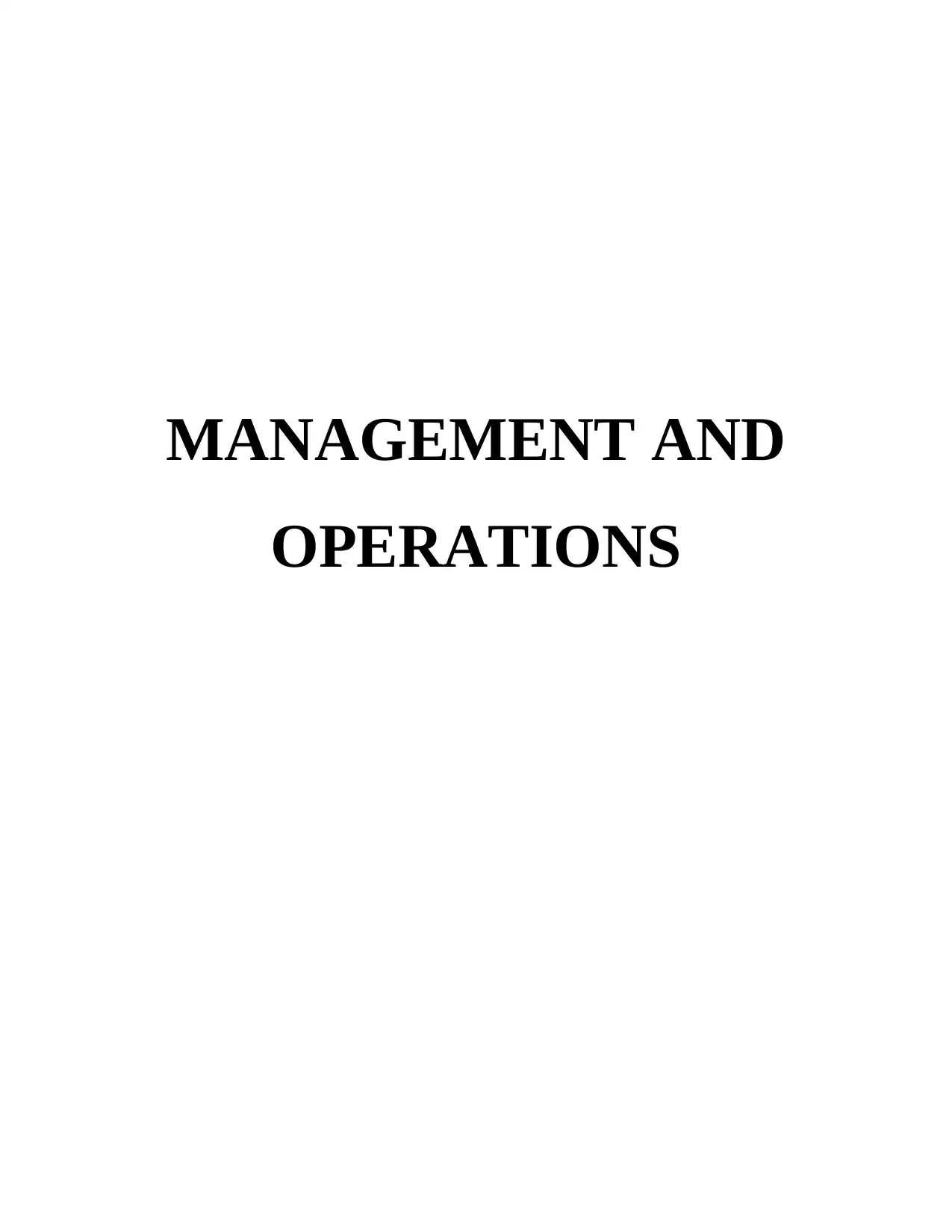
MANAGEMENT AND
OPERATIONS
OPERATIONS
Paraphrase This Document
Need a fresh take? Get an instant paraphrase of this document with our AI Paraphraser
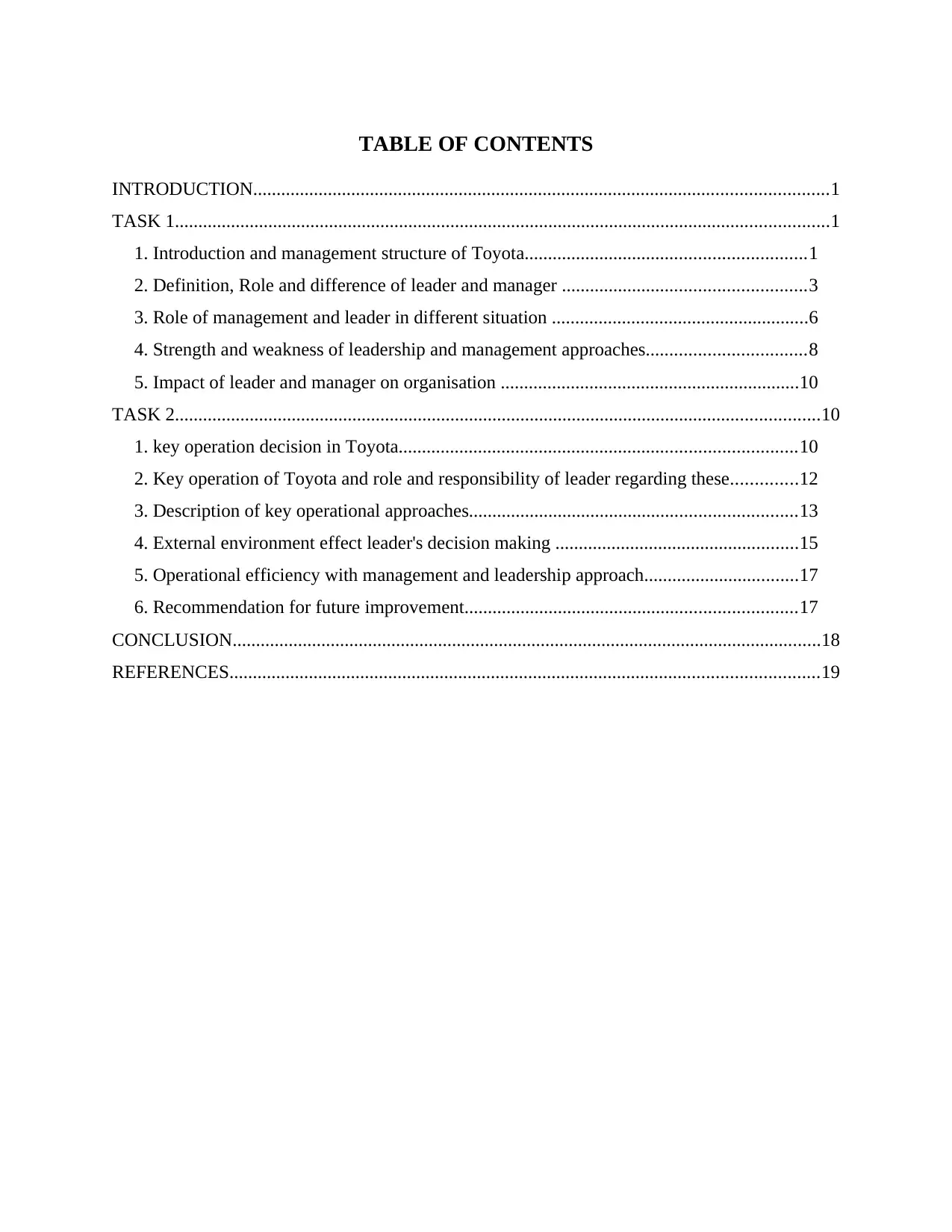
TABLE OF CONTENTS
INTRODUCTION...........................................................................................................................1
TASK 1............................................................................................................................................1
1. Introduction and management structure of Toyota............................................................1
2. Definition, Role and difference of leader and manager ....................................................3
3. Role of management and leader in different situation .......................................................6
4. Strength and weakness of leadership and management approaches..................................8
5. Impact of leader and manager on organisation ................................................................10
TASK 2..........................................................................................................................................10
1. key operation decision in Toyota.....................................................................................10
2. Key operation of Toyota and role and responsibility of leader regarding these..............12
3. Description of key operational approaches......................................................................13
4. External environment effect leader's decision making ....................................................15
5. Operational efficiency with management and leadership approach.................................17
6. Recommendation for future improvement.......................................................................17
CONCLUSION..............................................................................................................................18
REFERENCES..............................................................................................................................19
INTRODUCTION...........................................................................................................................1
TASK 1............................................................................................................................................1
1. Introduction and management structure of Toyota............................................................1
2. Definition, Role and difference of leader and manager ....................................................3
3. Role of management and leader in different situation .......................................................6
4. Strength and weakness of leadership and management approaches..................................8
5. Impact of leader and manager on organisation ................................................................10
TASK 2..........................................................................................................................................10
1. key operation decision in Toyota.....................................................................................10
2. Key operation of Toyota and role and responsibility of leader regarding these..............12
3. Description of key operational approaches......................................................................13
4. External environment effect leader's decision making ....................................................15
5. Operational efficiency with management and leadership approach.................................17
6. Recommendation for future improvement.......................................................................17
CONCLUSION..............................................................................................................................18
REFERENCES..............................................................................................................................19
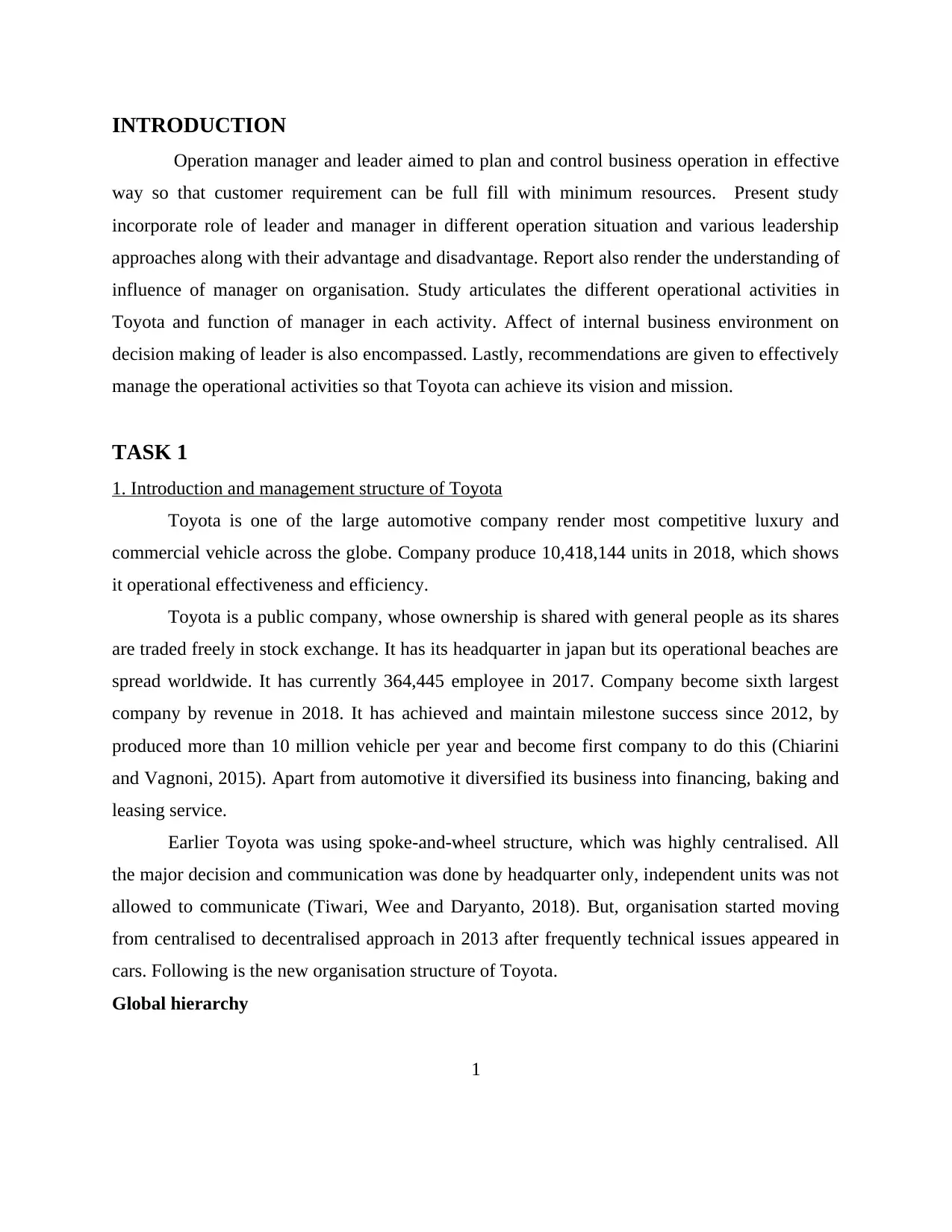
INTRODUCTION
Operation manager and leader aimed to plan and control business operation in effective
way so that customer requirement can be full fill with minimum resources. Present study
incorporate role of leader and manager in different operation situation and various leadership
approaches along with their advantage and disadvantage. Report also render the understanding of
influence of manager on organisation. Study articulates the different operational activities in
Toyota and function of manager in each activity. Affect of internal business environment on
decision making of leader is also encompassed. Lastly, recommendations are given to effectively
manage the operational activities so that Toyota can achieve its vision and mission.
TASK 1
1. Introduction and management structure of Toyota
Toyota is one of the large automotive company render most competitive luxury and
commercial vehicle across the globe. Company produce 10,418,144 units in 2018, which shows
it operational effectiveness and efficiency.
Toyota is a public company, whose ownership is shared with general people as its shares
are traded freely in stock exchange. It has its headquarter in japan but its operational beaches are
spread worldwide. It has currently 364,445 employee in 2017. Company become sixth largest
company by revenue in 2018. It has achieved and maintain milestone success since 2012, by
produced more than 10 million vehicle per year and become first company to do this (Chiarini
and Vagnoni, 2015). Apart from automotive it diversified its business into financing, baking and
leasing service.
Earlier Toyota was using spoke-and-wheel structure, which was highly centralised. All
the major decision and communication was done by headquarter only, independent units was not
allowed to communicate (Tiwari, Wee and Daryanto, 2018). But, organisation started moving
from centralised to decentralised approach in 2013 after frequently technical issues appeared in
cars. Following is the new organisation structure of Toyota.
Global hierarchy
1
Operation manager and leader aimed to plan and control business operation in effective
way so that customer requirement can be full fill with minimum resources. Present study
incorporate role of leader and manager in different operation situation and various leadership
approaches along with their advantage and disadvantage. Report also render the understanding of
influence of manager on organisation. Study articulates the different operational activities in
Toyota and function of manager in each activity. Affect of internal business environment on
decision making of leader is also encompassed. Lastly, recommendations are given to effectively
manage the operational activities so that Toyota can achieve its vision and mission.
TASK 1
1. Introduction and management structure of Toyota
Toyota is one of the large automotive company render most competitive luxury and
commercial vehicle across the globe. Company produce 10,418,144 units in 2018, which shows
it operational effectiveness and efficiency.
Toyota is a public company, whose ownership is shared with general people as its shares
are traded freely in stock exchange. It has its headquarter in japan but its operational beaches are
spread worldwide. It has currently 364,445 employee in 2017. Company become sixth largest
company by revenue in 2018. It has achieved and maintain milestone success since 2012, by
produced more than 10 million vehicle per year and become first company to do this (Chiarini
and Vagnoni, 2015). Apart from automotive it diversified its business into financing, baking and
leasing service.
Earlier Toyota was using spoke-and-wheel structure, which was highly centralised. All
the major decision and communication was done by headquarter only, independent units was not
allowed to communicate (Tiwari, Wee and Daryanto, 2018). But, organisation started moving
from centralised to decentralised approach in 2013 after frequently technical issues appeared in
cars. Following is the new organisation structure of Toyota.
Global hierarchy
1
⊘ This is a preview!⊘
Do you want full access?
Subscribe today to unlock all pages.

Trusted by 1+ million students worldwide
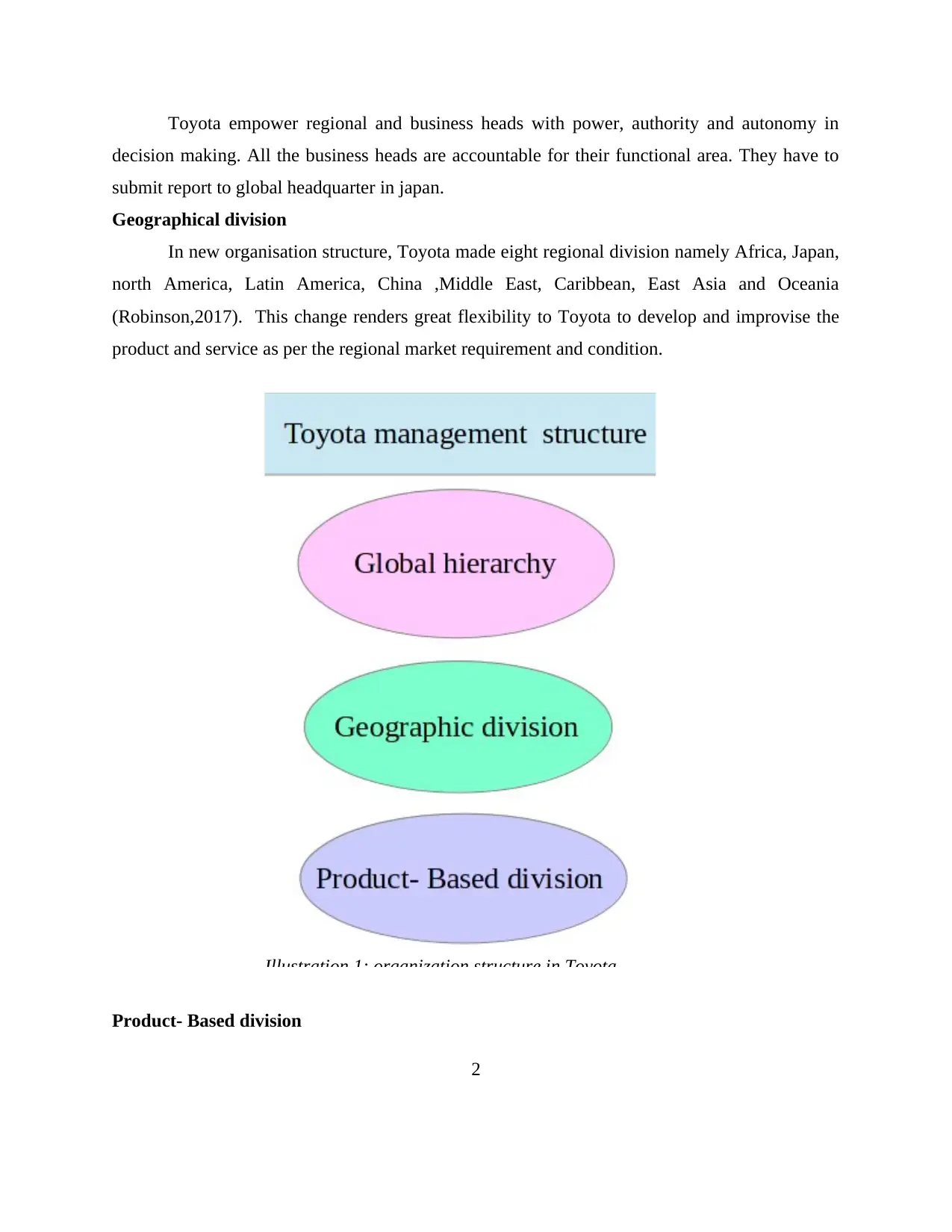
Toyota empower regional and business heads with power, authority and autonomy in
decision making. All the business heads are accountable for their functional area. They have to
submit report to global headquarter in japan.
Geographical division
In new organisation structure, Toyota made eight regional division namely Africa, Japan,
north America, Latin America, China ,Middle East, Caribbean, East Asia and Oceania
(Robinson,2017). This change renders great flexibility to Toyota to develop and improvise the
product and service as per the regional market requirement and condition.
Product- Based division
2
Illustration 1: organization structure in Toyota
decision making. All the business heads are accountable for their functional area. They have to
submit report to global headquarter in japan.
Geographical division
In new organisation structure, Toyota made eight regional division namely Africa, Japan,
north America, Latin America, China ,Middle East, Caribbean, East Asia and Oceania
(Robinson,2017). This change renders great flexibility to Toyota to develop and improvise the
product and service as per the regional market requirement and condition.
Product- Based division
2
Illustration 1: organization structure in Toyota
Paraphrase This Document
Need a fresh take? Get an instant paraphrase of this document with our AI Paraphraser
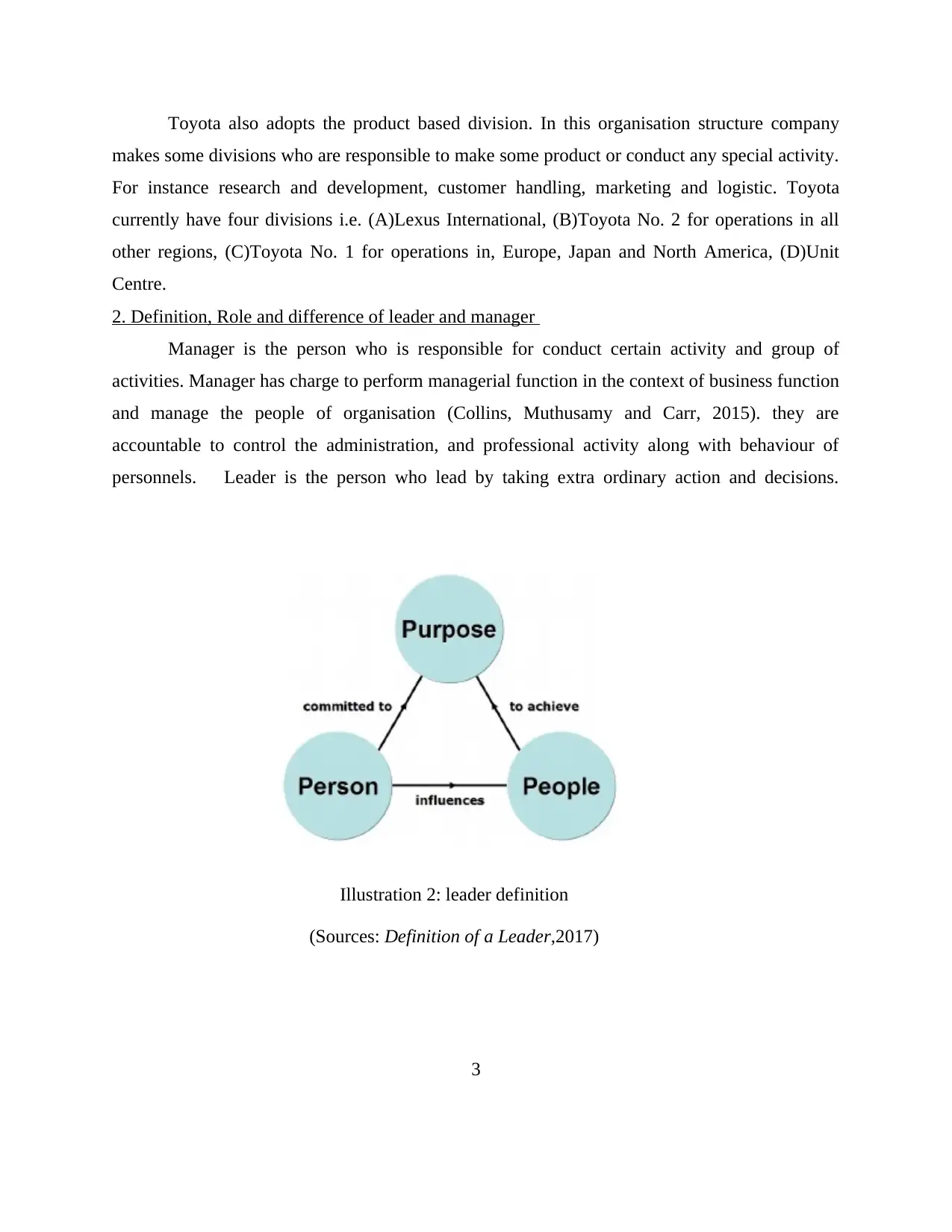
Toyota also adopts the product based division. In this organisation structure company
makes some divisions who are responsible to make some product or conduct any special activity.
For instance research and development, customer handling, marketing and logistic. Toyota
currently have four divisions i.e. (A)Lexus International, (B)Toyota No. 2 for operations in all
other regions, (C)Toyota No. 1 for operations in, Europe, Japan and North America, (D)Unit
Centre.
2. Definition, Role and difference of leader and manager
Manager is the person who is responsible for conduct certain activity and group of
activities. Manager has charge to perform managerial function in the context of business function
and manage the people of organisation (Collins, Muthusamy and Carr, 2015). they are
accountable to control the administration, and professional activity along with behaviour of
personnels. Leader is the person who lead by taking extra ordinary action and decisions.
3
Illustration 2: leader definition
(Sources: Definition of a Leader,2017)
makes some divisions who are responsible to make some product or conduct any special activity.
For instance research and development, customer handling, marketing and logistic. Toyota
currently have four divisions i.e. (A)Lexus International, (B)Toyota No. 2 for operations in all
other regions, (C)Toyota No. 1 for operations in, Europe, Japan and North America, (D)Unit
Centre.
2. Definition, Role and difference of leader and manager
Manager is the person who is responsible for conduct certain activity and group of
activities. Manager has charge to perform managerial function in the context of business function
and manage the people of organisation (Collins, Muthusamy and Carr, 2015). they are
accountable to control the administration, and professional activity along with behaviour of
personnels. Leader is the person who lead by taking extra ordinary action and decisions.
3
Illustration 2: leader definition
(Sources: Definition of a Leader,2017)
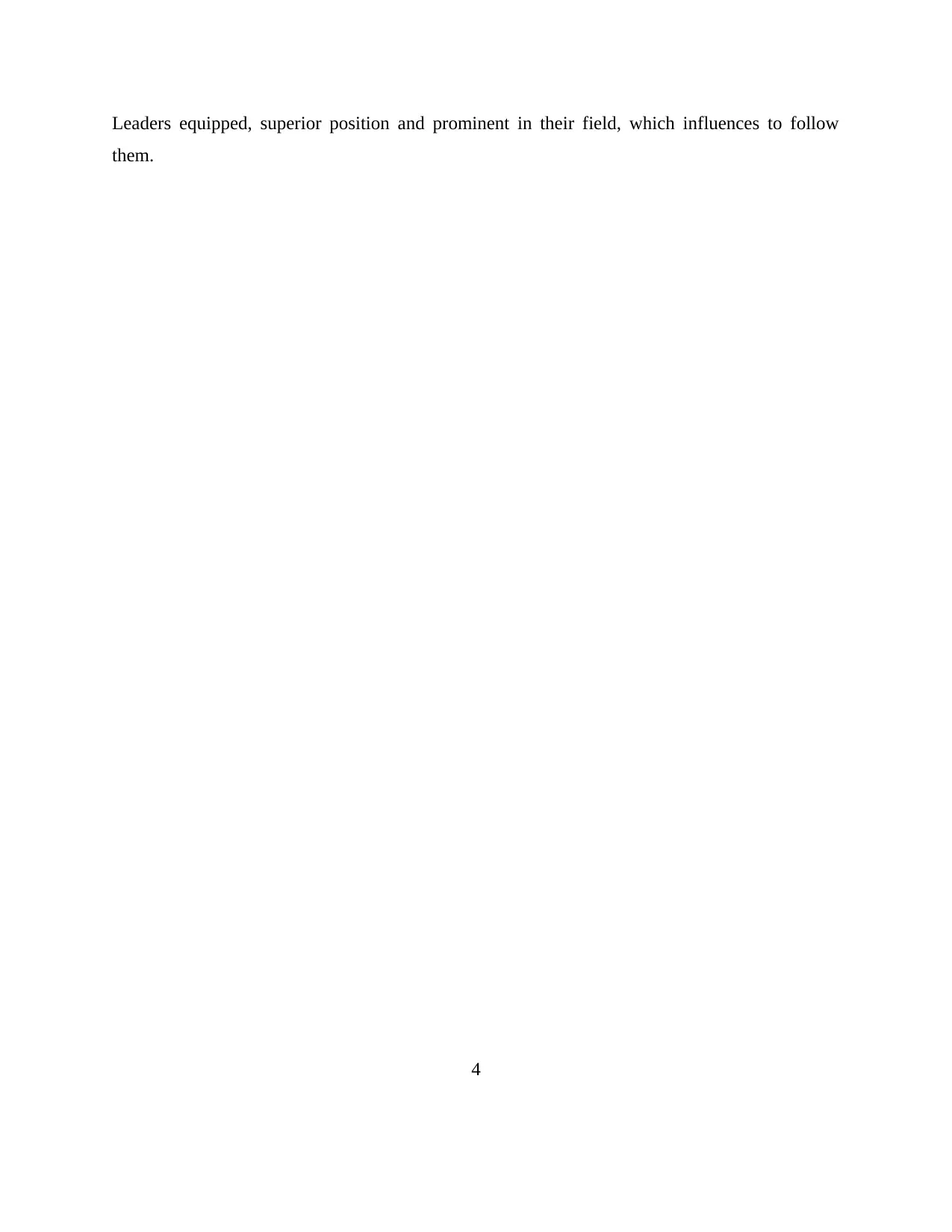
Leaders equipped, superior position and prominent in their field, which influences to follow
them.
4
them.
4
⊘ This is a preview!⊘
Do you want full access?
Subscribe today to unlock all pages.

Trusted by 1+ million students worldwide
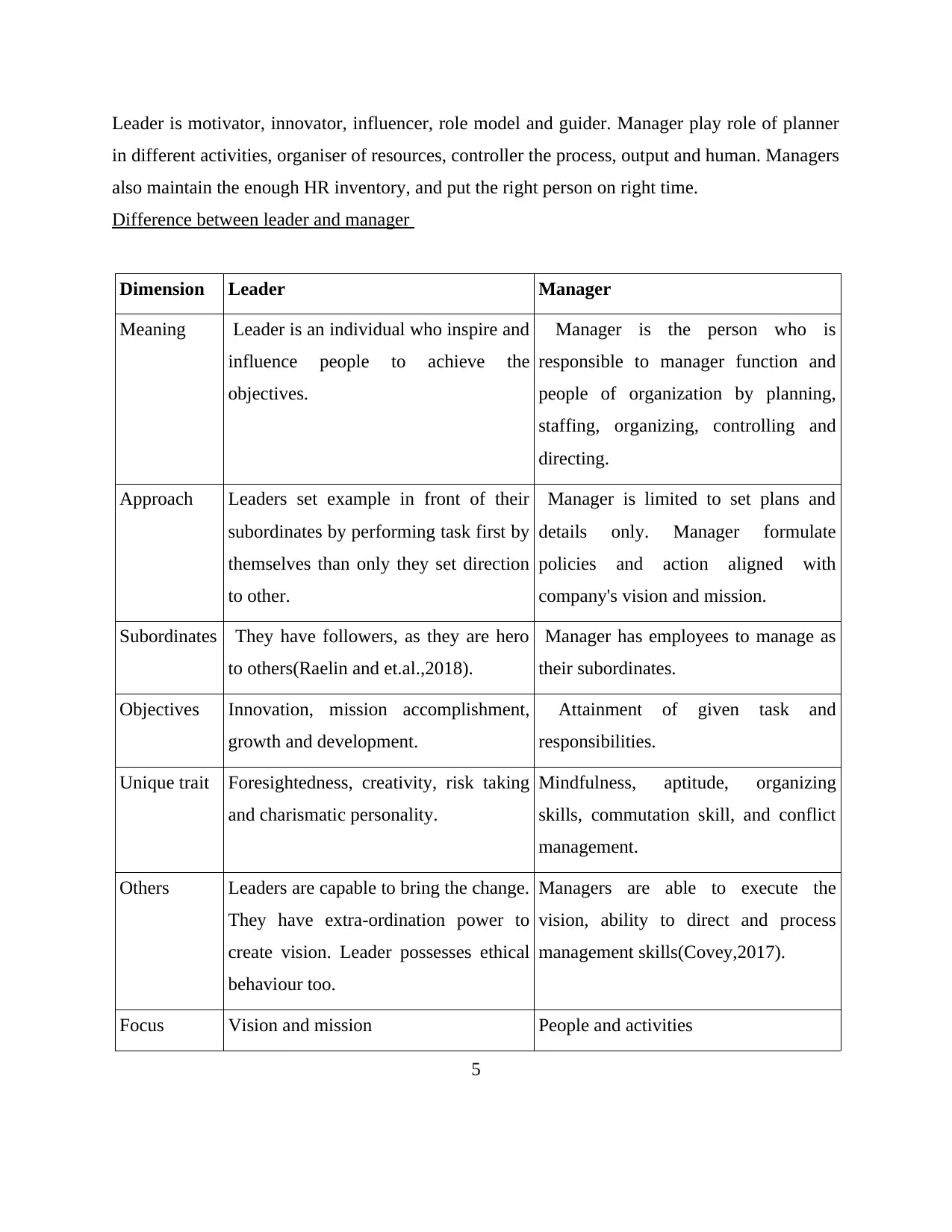
Leader is motivator, innovator, influencer, role model and guider. Manager play role of planner
in different activities, organiser of resources, controller the process, output and human. Managers
also maintain the enough HR inventory, and put the right person on right time.
Difference between leader and manager
Dimension Leader Manager
Meaning Leader is an individual who inspire and
influence people to achieve the
objectives.
Manager is the person who is
responsible to manager function and
people of organization by planning,
staffing, organizing, controlling and
directing.
Approach Leaders set example in front of their
subordinates by performing task first by
themselves than only they set direction
to other.
Manager is limited to set plans and
details only. Manager formulate
policies and action aligned with
company's vision and mission.
Subordinates They have followers, as they are hero
to others(Raelin and et.al.,2018).
Manager has employees to manage as
their subordinates.
Objectives Innovation, mission accomplishment,
growth and development.
Attainment of given task and
responsibilities.
Unique trait Foresightedness, creativity, risk taking
and charismatic personality.
Mindfulness, aptitude, organizing
skills, commutation skill, and conflict
management.
Others Leaders are capable to bring the change.
They have extra-ordination power to
create vision. Leader possesses ethical
behaviour too.
Managers are able to execute the
vision, ability to direct and process
management skills(Covey,2017).
Focus Vision and mission People and activities
5
in different activities, organiser of resources, controller the process, output and human. Managers
also maintain the enough HR inventory, and put the right person on right time.
Difference between leader and manager
Dimension Leader Manager
Meaning Leader is an individual who inspire and
influence people to achieve the
objectives.
Manager is the person who is
responsible to manager function and
people of organization by planning,
staffing, organizing, controlling and
directing.
Approach Leaders set example in front of their
subordinates by performing task first by
themselves than only they set direction
to other.
Manager is limited to set plans and
details only. Manager formulate
policies and action aligned with
company's vision and mission.
Subordinates They have followers, as they are hero
to others(Raelin and et.al.,2018).
Manager has employees to manage as
their subordinates.
Objectives Innovation, mission accomplishment,
growth and development.
Attainment of given task and
responsibilities.
Unique trait Foresightedness, creativity, risk taking
and charismatic personality.
Mindfulness, aptitude, organizing
skills, commutation skill, and conflict
management.
Others Leaders are capable to bring the change.
They have extra-ordination power to
create vision. Leader possesses ethical
behaviour too.
Managers are able to execute the
vision, ability to direct and process
management skills(Covey,2017).
Focus Vision and mission People and activities
5
Paraphrase This Document
Need a fresh take? Get an instant paraphrase of this document with our AI Paraphraser
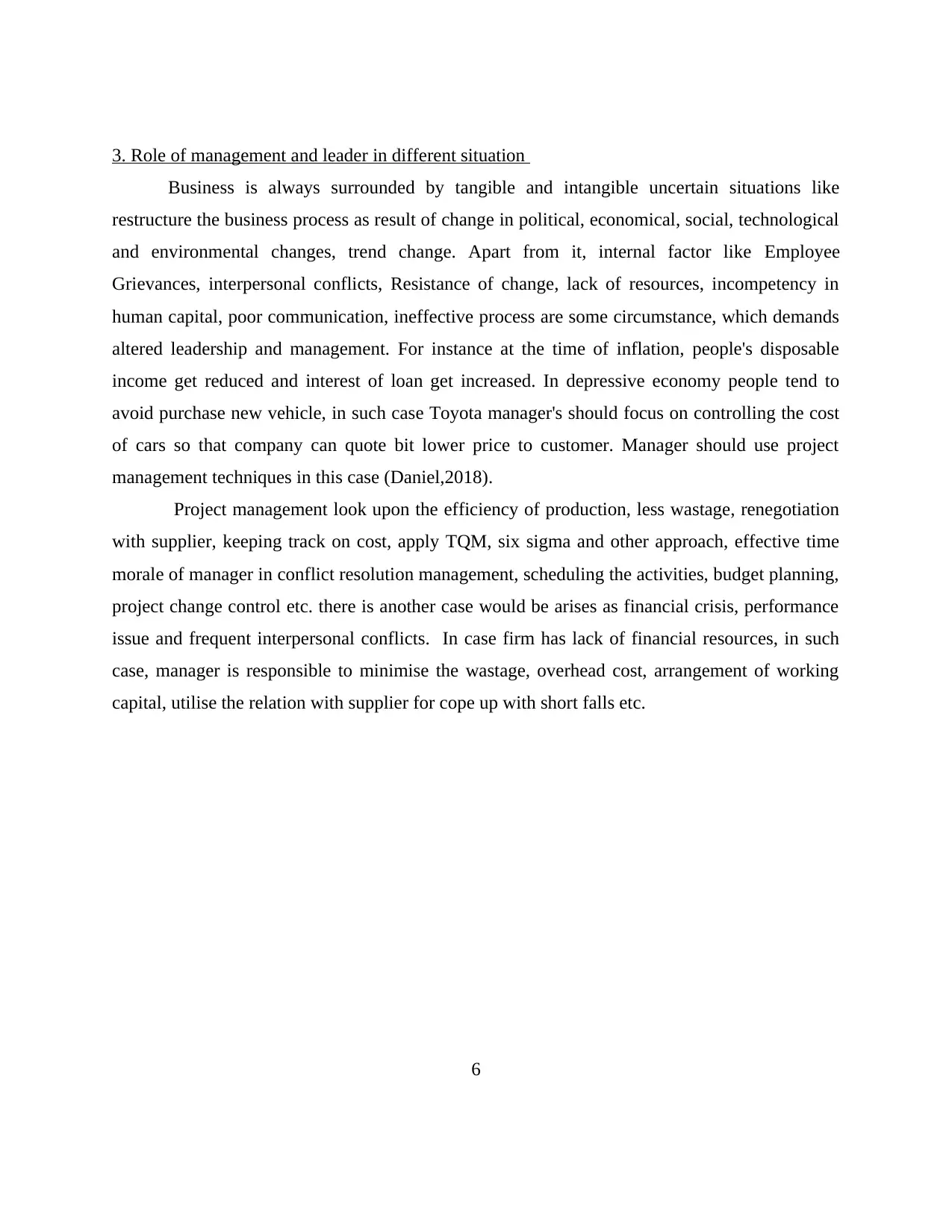
3. Role of management and leader in different situation
Business is always surrounded by tangible and intangible uncertain situations like
restructure the business process as result of change in political, economical, social, technological
and environmental changes, trend change. Apart from it, internal factor like Employee
Grievances, interpersonal conflicts, Resistance of change, lack of resources, incompetency in
human capital, poor communication, ineffective process are some circumstance, which demands
altered leadership and management. For instance at the time of inflation, people's disposable
income get reduced and interest of loan get increased. In depressive economy people tend to
avoid purchase new vehicle, in such case Toyota manager's should focus on controlling the cost
of cars so that company can quote bit lower price to customer. Manager should use project
management techniques in this case (Daniel,2018).
Project management look upon the efficiency of production, less wastage, renegotiation
with supplier, keeping track on cost, apply TQM, six sigma and other approach, effective time
morale of manager in conflict resolution management, scheduling the activities, budget planning,
project change control etc. there is another case would be arises as financial crisis, performance
issue and frequent interpersonal conflicts. In case firm has lack of financial resources, in such
case, manager is responsible to minimise the wastage, overhead cost, arrangement of working
capital, utilise the relation with supplier for cope up with short falls etc.
6
Business is always surrounded by tangible and intangible uncertain situations like
restructure the business process as result of change in political, economical, social, technological
and environmental changes, trend change. Apart from it, internal factor like Employee
Grievances, interpersonal conflicts, Resistance of change, lack of resources, incompetency in
human capital, poor communication, ineffective process are some circumstance, which demands
altered leadership and management. For instance at the time of inflation, people's disposable
income get reduced and interest of loan get increased. In depressive economy people tend to
avoid purchase new vehicle, in such case Toyota manager's should focus on controlling the cost
of cars so that company can quote bit lower price to customer. Manager should use project
management techniques in this case (Daniel,2018).
Project management look upon the efficiency of production, less wastage, renegotiation
with supplier, keeping track on cost, apply TQM, six sigma and other approach, effective time
morale of manager in conflict resolution management, scheduling the activities, budget planning,
project change control etc. there is another case would be arises as financial crisis, performance
issue and frequent interpersonal conflicts. In case firm has lack of financial resources, in such
case, manager is responsible to minimise the wastage, overhead cost, arrangement of working
capital, utilise the relation with supplier for cope up with short falls etc.
6
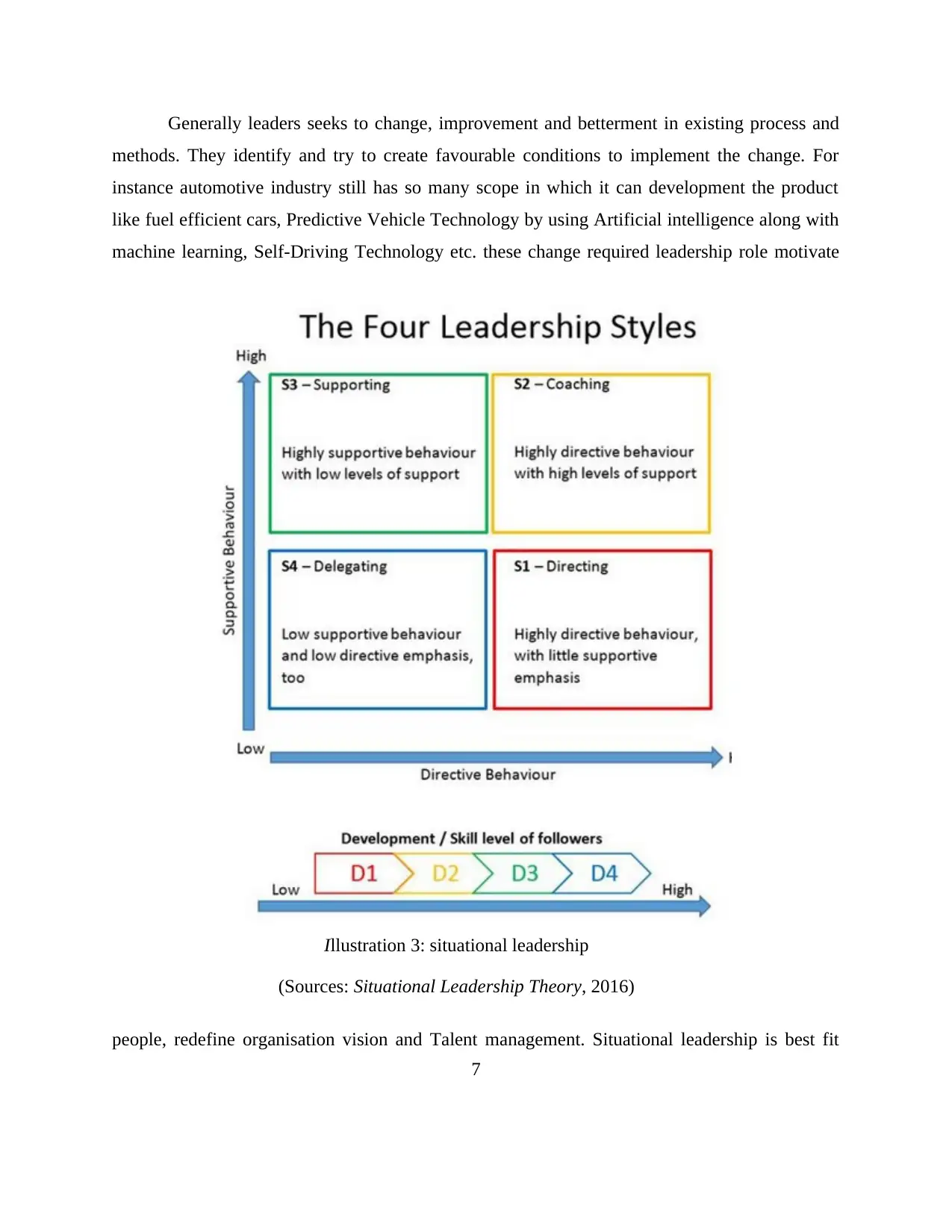
Generally leaders seeks to change, improvement and betterment in existing process and
methods. They identify and try to create favourable conditions to implement the change. For
instance automotive industry still has so many scope in which it can development the product
like fuel efficient cars, Predictive Vehicle Technology by using Artificial intelligence along with
machine learning, Self-Driving Technology etc. these change required leadership role motivate
people, redefine organisation vision and Talent management. Situational leadership is best fit
7
Illustration 3: situational leadership
(Sources: Situational Leadership Theory, 2016)
methods. They identify and try to create favourable conditions to implement the change. For
instance automotive industry still has so many scope in which it can development the product
like fuel efficient cars, Predictive Vehicle Technology by using Artificial intelligence along with
machine learning, Self-Driving Technology etc. these change required leadership role motivate
people, redefine organisation vision and Talent management. Situational leadership is best fit
7
Illustration 3: situational leadership
(Sources: Situational Leadership Theory, 2016)
⊘ This is a preview!⊘
Do you want full access?
Subscribe today to unlock all pages.

Trusted by 1+ million students worldwide
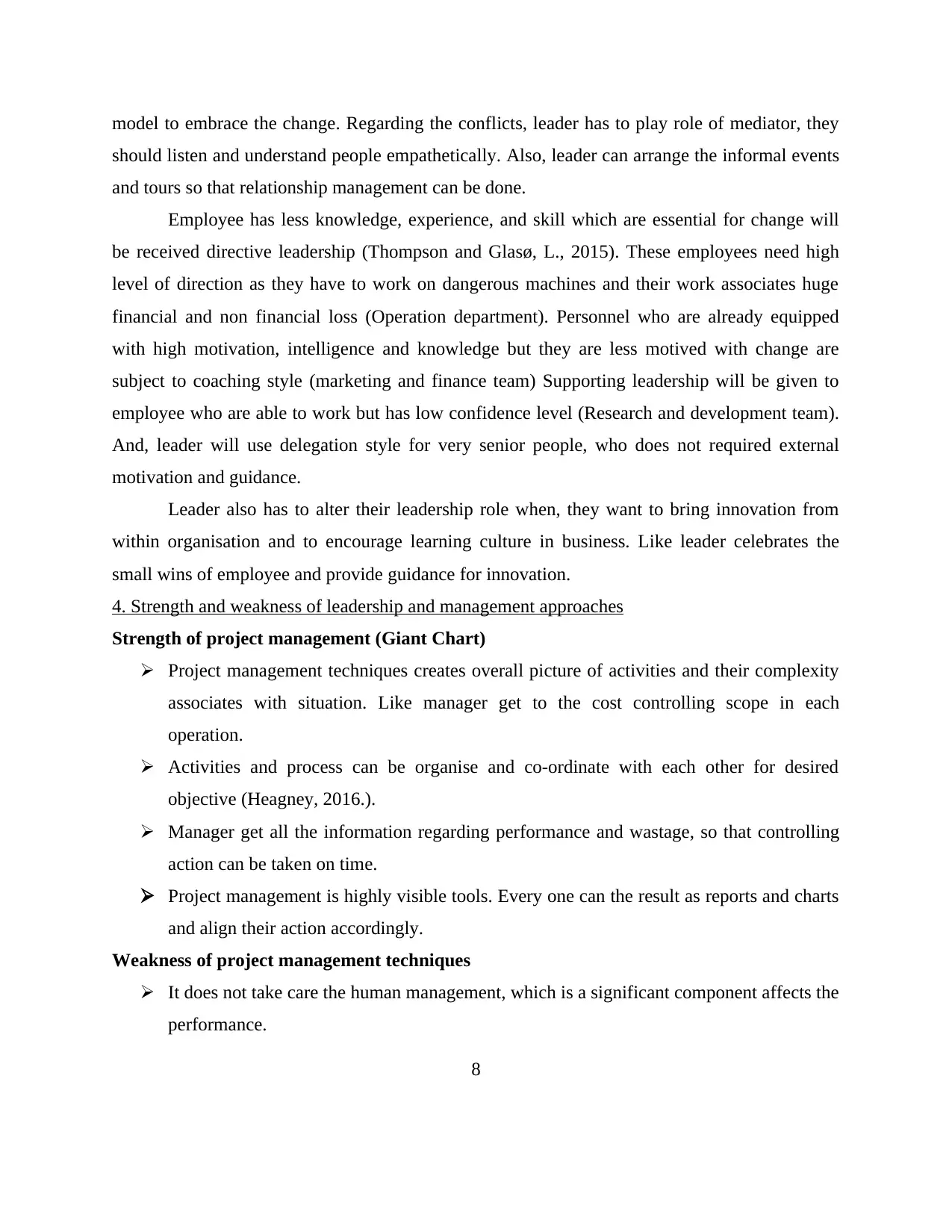
model to embrace the change. Regarding the conflicts, leader has to play role of mediator, they
should listen and understand people empathetically. Also, leader can arrange the informal events
and tours so that relationship management can be done.
Employee has less knowledge, experience, and skill which are essential for change will
be received directive leadership (Thompson and Glasø, L., 2015). These employees need high
level of direction as they have to work on dangerous machines and their work associates huge
financial and non financial loss (Operation department). Personnel who are already equipped
with high motivation, intelligence and knowledge but they are less motived with change are
subject to coaching style (marketing and finance team) Supporting leadership will be given to
employee who are able to work but has low confidence level (Research and development team).
And, leader will use delegation style for very senior people, who does not required external
motivation and guidance.
Leader also has to alter their leadership role when, they want to bring innovation from
within organisation and to encourage learning culture in business. Like leader celebrates the
small wins of employee and provide guidance for innovation.
4. Strength and weakness of leadership and management approaches
Strength of project management (Giant Chart)
Project management techniques creates overall picture of activities and their complexity
associates with situation. Like manager get to the cost controlling scope in each
operation.
Activities and process can be organise and co-ordinate with each other for desired
objective (Heagney, 2016.).
Manager get all the information regarding performance and wastage, so that controlling
action can be taken on time.
Project management is highly visible tools. Every one can the result as reports and charts
and align their action accordingly.
Weakness of project management techniques
It does not take care the human management, which is a significant component affects the
performance.
8
should listen and understand people empathetically. Also, leader can arrange the informal events
and tours so that relationship management can be done.
Employee has less knowledge, experience, and skill which are essential for change will
be received directive leadership (Thompson and Glasø, L., 2015). These employees need high
level of direction as they have to work on dangerous machines and their work associates huge
financial and non financial loss (Operation department). Personnel who are already equipped
with high motivation, intelligence and knowledge but they are less motived with change are
subject to coaching style (marketing and finance team) Supporting leadership will be given to
employee who are able to work but has low confidence level (Research and development team).
And, leader will use delegation style for very senior people, who does not required external
motivation and guidance.
Leader also has to alter their leadership role when, they want to bring innovation from
within organisation and to encourage learning culture in business. Like leader celebrates the
small wins of employee and provide guidance for innovation.
4. Strength and weakness of leadership and management approaches
Strength of project management (Giant Chart)
Project management techniques creates overall picture of activities and their complexity
associates with situation. Like manager get to the cost controlling scope in each
operation.
Activities and process can be organise and co-ordinate with each other for desired
objective (Heagney, 2016.).
Manager get all the information regarding performance and wastage, so that controlling
action can be taken on time.
Project management is highly visible tools. Every one can the result as reports and charts
and align their action accordingly.
Weakness of project management techniques
It does not take care the human management, which is a significant component affects the
performance.
8
Paraphrase This Document
Need a fresh take? Get an instant paraphrase of this document with our AI Paraphraser
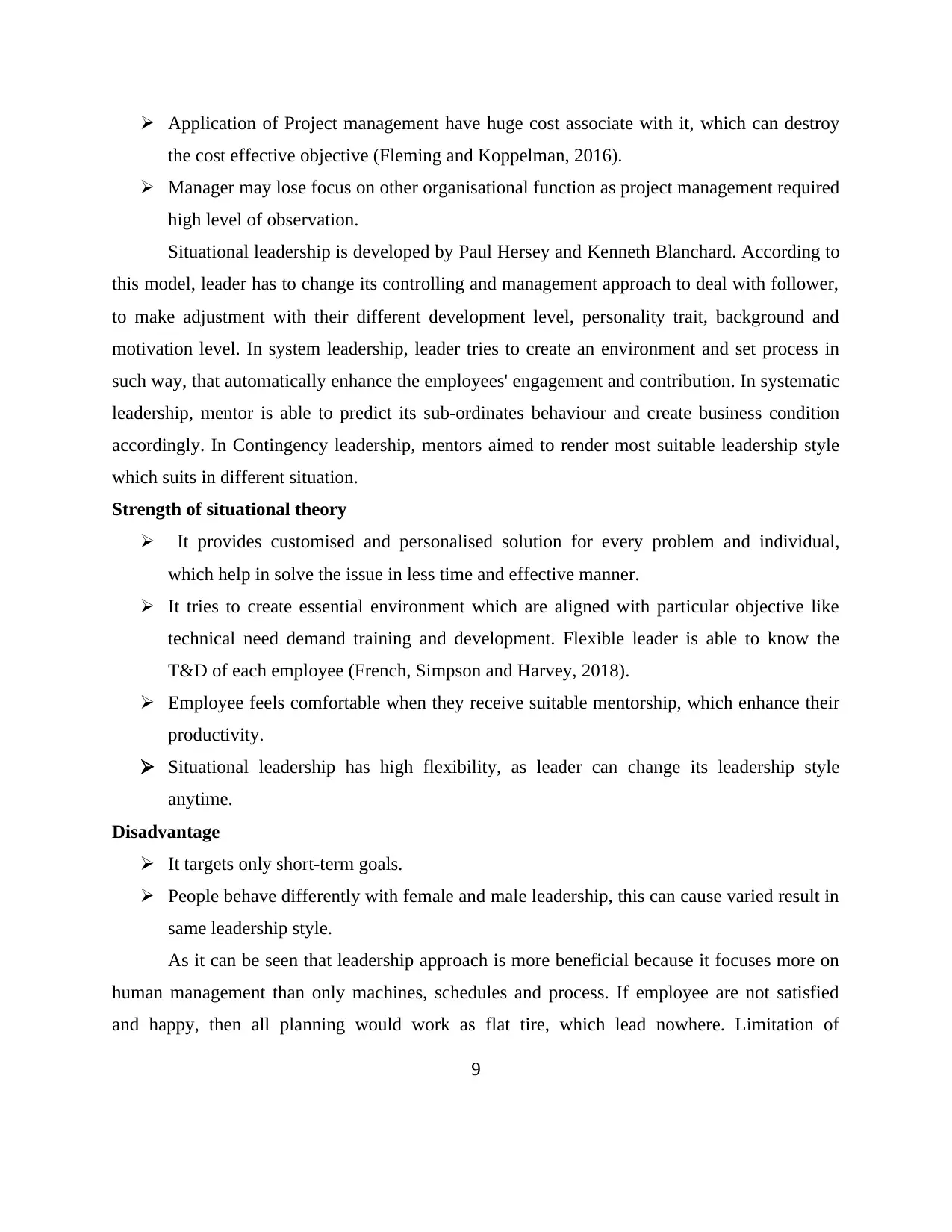
Application of Project management have huge cost associate with it, which can destroy
the cost effective objective (Fleming and Koppelman, 2016).
Manager may lose focus on other organisational function as project management required
high level of observation.
Situational leadership is developed by Paul Hersey and Kenneth Blanchard. According to
this model, leader has to change its controlling and management approach to deal with follower,
to make adjustment with their different development level, personality trait, background and
motivation level. In system leadership, leader tries to create an environment and set process in
such way, that automatically enhance the employees' engagement and contribution. In systematic
leadership, mentor is able to predict its sub-ordinates behaviour and create business condition
accordingly. In Contingency leadership, mentors aimed to render most suitable leadership style
which suits in different situation.
Strength of situational theory
It provides customised and personalised solution for every problem and individual,
which help in solve the issue in less time and effective manner.
It tries to create essential environment which are aligned with particular objective like
technical need demand training and development. Flexible leader is able to know the
T&D of each employee (French, Simpson and Harvey, 2018).
Employee feels comfortable when they receive suitable mentorship, which enhance their
productivity.
Situational leadership has high flexibility, as leader can change its leadership style
anytime.
Disadvantage
It targets only short-term goals.
People behave differently with female and male leadership, this can cause varied result in
same leadership style.
As it can be seen that leadership approach is more beneficial because it focuses more on
human management than only machines, schedules and process. If employee are not satisfied
and happy, then all planning would work as flat tire, which lead nowhere. Limitation of
9
the cost effective objective (Fleming and Koppelman, 2016).
Manager may lose focus on other organisational function as project management required
high level of observation.
Situational leadership is developed by Paul Hersey and Kenneth Blanchard. According to
this model, leader has to change its controlling and management approach to deal with follower,
to make adjustment with their different development level, personality trait, background and
motivation level. In system leadership, leader tries to create an environment and set process in
such way, that automatically enhance the employees' engagement and contribution. In systematic
leadership, mentor is able to predict its sub-ordinates behaviour and create business condition
accordingly. In Contingency leadership, mentors aimed to render most suitable leadership style
which suits in different situation.
Strength of situational theory
It provides customised and personalised solution for every problem and individual,
which help in solve the issue in less time and effective manner.
It tries to create essential environment which are aligned with particular objective like
technical need demand training and development. Flexible leader is able to know the
T&D of each employee (French, Simpson and Harvey, 2018).
Employee feels comfortable when they receive suitable mentorship, which enhance their
productivity.
Situational leadership has high flexibility, as leader can change its leadership style
anytime.
Disadvantage
It targets only short-term goals.
People behave differently with female and male leadership, this can cause varied result in
same leadership style.
As it can be seen that leadership approach is more beneficial because it focuses more on
human management than only machines, schedules and process. If employee are not satisfied
and happy, then all planning would work as flat tire, which lead nowhere. Limitation of
9
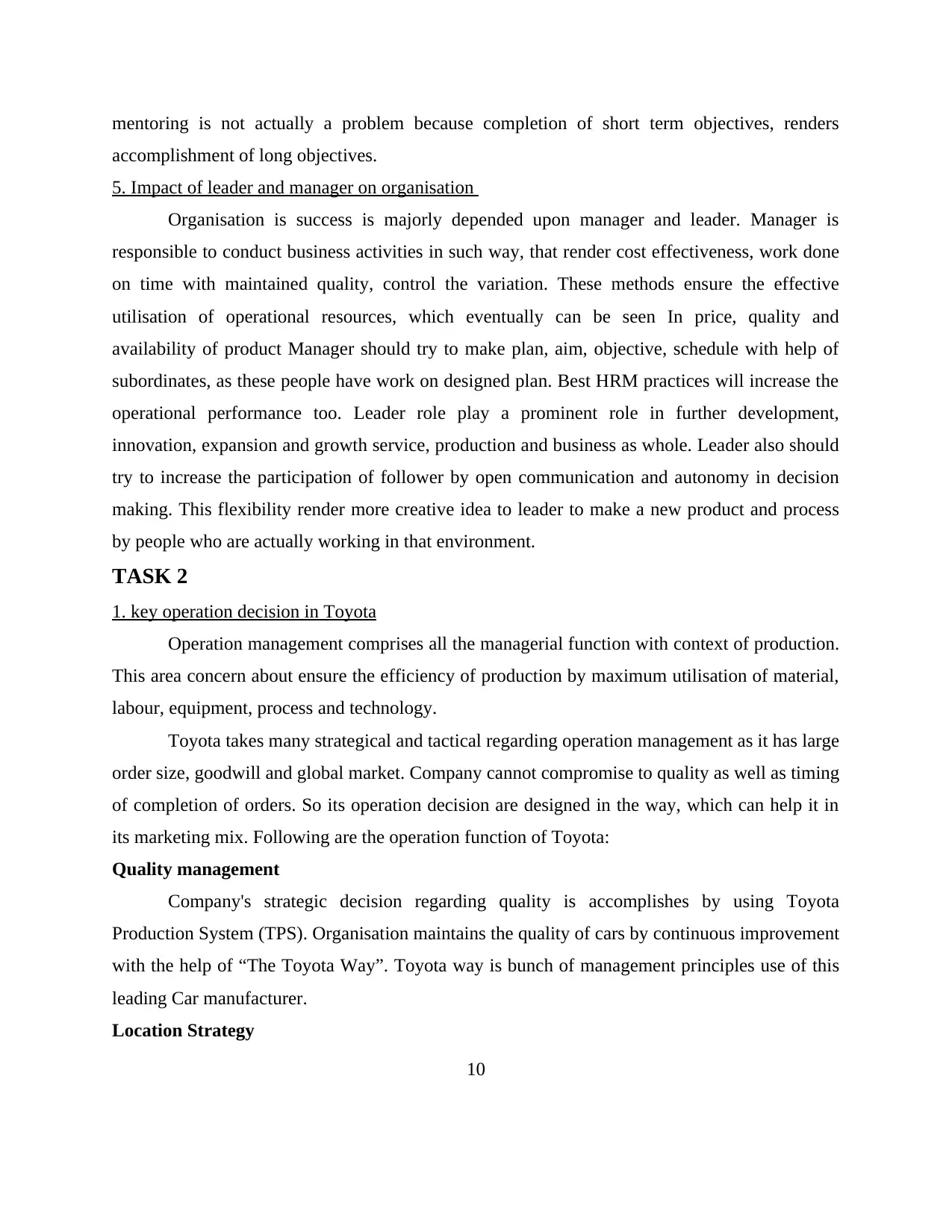
mentoring is not actually a problem because completion of short term objectives, renders
accomplishment of long objectives.
5. Impact of leader and manager on organisation
Organisation is success is majorly depended upon manager and leader. Manager is
responsible to conduct business activities in such way, that render cost effectiveness, work done
on time with maintained quality, control the variation. These methods ensure the effective
utilisation of operational resources, which eventually can be seen In price, quality and
availability of product Manager should try to make plan, aim, objective, schedule with help of
subordinates, as these people have work on designed plan. Best HRM practices will increase the
operational performance too. Leader role play a prominent role in further development,
innovation, expansion and growth service, production and business as whole. Leader also should
try to increase the participation of follower by open communication and autonomy in decision
making. This flexibility render more creative idea to leader to make a new product and process
by people who are actually working in that environment.
TASK 2
1. key operation decision in Toyota
Operation management comprises all the managerial function with context of production.
This area concern about ensure the efficiency of production by maximum utilisation of material,
labour, equipment, process and technology.
Toyota takes many strategical and tactical regarding operation management as it has large
order size, goodwill and global market. Company cannot compromise to quality as well as timing
of completion of orders. So its operation decision are designed in the way, which can help it in
its marketing mix. Following are the operation function of Toyota:
Quality management
Company's strategic decision regarding quality is accomplishes by using Toyota
Production System (TPS). Organisation maintains the quality of cars by continuous improvement
with the help of “The Toyota Way”. Toyota way is bunch of management principles use of this
leading Car manufacturer.
Location Strategy
10
accomplishment of long objectives.
5. Impact of leader and manager on organisation
Organisation is success is majorly depended upon manager and leader. Manager is
responsible to conduct business activities in such way, that render cost effectiveness, work done
on time with maintained quality, control the variation. These methods ensure the effective
utilisation of operational resources, which eventually can be seen In price, quality and
availability of product Manager should try to make plan, aim, objective, schedule with help of
subordinates, as these people have work on designed plan. Best HRM practices will increase the
operational performance too. Leader role play a prominent role in further development,
innovation, expansion and growth service, production and business as whole. Leader also should
try to increase the participation of follower by open communication and autonomy in decision
making. This flexibility render more creative idea to leader to make a new product and process
by people who are actually working in that environment.
TASK 2
1. key operation decision in Toyota
Operation management comprises all the managerial function with context of production.
This area concern about ensure the efficiency of production by maximum utilisation of material,
labour, equipment, process and technology.
Toyota takes many strategical and tactical regarding operation management as it has large
order size, goodwill and global market. Company cannot compromise to quality as well as timing
of completion of orders. So its operation decision are designed in the way, which can help it in
its marketing mix. Following are the operation function of Toyota:
Quality management
Company's strategic decision regarding quality is accomplishes by using Toyota
Production System (TPS). Organisation maintains the quality of cars by continuous improvement
with the help of “The Toyota Way”. Toyota way is bunch of management principles use of this
leading Car manufacturer.
Location Strategy
10
⊘ This is a preview!⊘
Do you want full access?
Subscribe today to unlock all pages.

Trusted by 1+ million students worldwide
1 out of 22
Related Documents
Your All-in-One AI-Powered Toolkit for Academic Success.
+13062052269
info@desklib.com
Available 24*7 on WhatsApp / Email
![[object Object]](/_next/static/media/star-bottom.7253800d.svg)
Unlock your academic potential
Copyright © 2020–2025 A2Z Services. All Rights Reserved. Developed and managed by ZUCOL.





